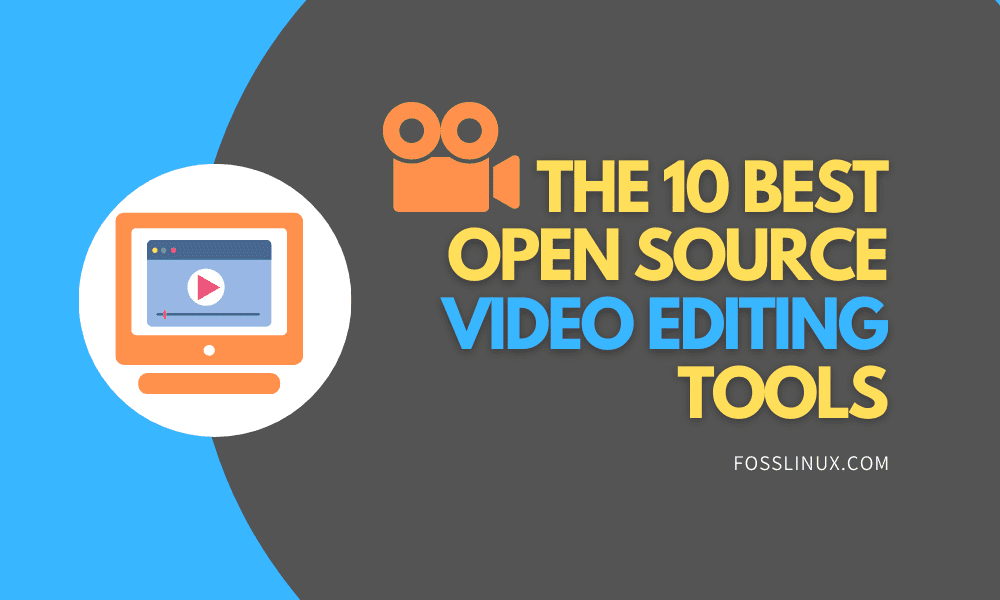Although mainstream video editors such as Adobe Premiere Pro, Final Cut Pro, and Filmora get the job done (and that too, quite well), their subscription packages can cost an arm and a leg. Accordingly, it won’t be wrong to say that not everyone would be able to afford such pricey software. If you feel the same way, you’re in luck as there are plenty of free and open-source video editors out there, which you can not just free but also make changes as per your needs if you know a thing or two about coding.
Best Open-Source Video Editors
When compiling this list of the best open-source video editors, we thought to look for only those with cross-platform availability, so you can run it on any operating system without jumping ships to Linux. If we have got you interested, let’s discuss the open-source software that you’ll wish you knew about sooner.
1. Kdenlive

KDE Kdenlive
Hands down: Kdenlive is the undisputed king of free video editing software. First, it provides users with a full-fledged video editing experience with a user interface that shouldn’t take quite a while to get the hang of. If you’ve used iMovie or any other similar-looking application in the past, it’ll be even easier for you to get accustomed to using Kdenlive.
Apart from basic video editing features like cutting, cropping, and moving the clips, this video editor also supports unlimited video/audio tracks, preview rendering, the oh-so-useful “JKL” playback shortcuts, and customization of its shortcuts and interface. It has its own built-in set of various transitions and effects, but it also allows users to create new ones.
When it comes to supported file formats, Kdenlive truly shines brightest in that department since it can work with a wide variety of video/audio formats, courtesy of its FFmpeg libraries. Lastly, this application is available on operating systems, including Windows, macOS, and Linux. However, there would be a need for manual compilation and installation on macOS devices.
2. Shotcut
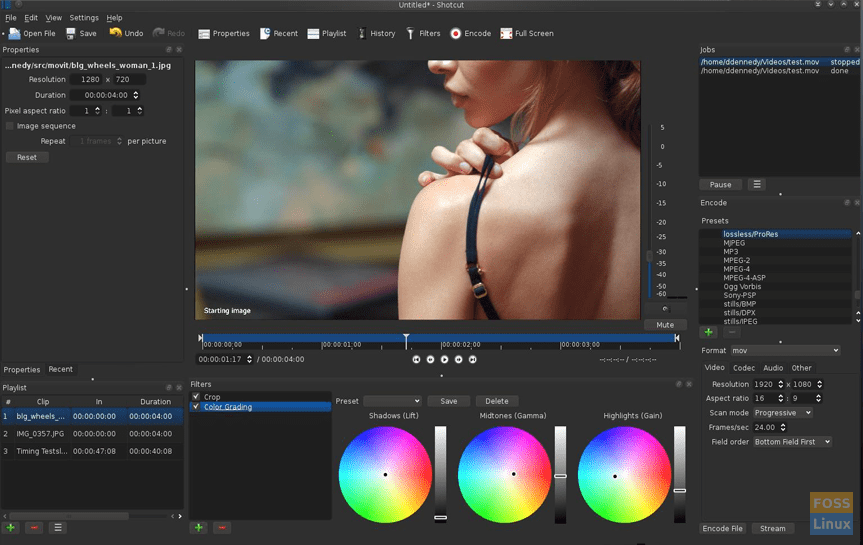
Shotcut
This is another free, open-source software that lets you get a real video editing experience. Although Shotcut might not look that advanced from the get-go, you shouldn’t mistake its simple user interface for its lack of features. The software even comes with keyboard shortcuts that allow users to quickly add, split, and trim clips. Other than that, you’ll also find a plethora of stackable filters and video/audio transitions and not to mention green-screen effects.
Although Shotcut offers several advanced features, those new to the application would need some time to utilize them correctly. Moreover, the software supports a wide range of video/audio formats and allows users to work with dual-monitors and 4K videos. Its supported platforms include Linux, macOS, and Windows (for which it even provides a portable version.)
3. OpenShot
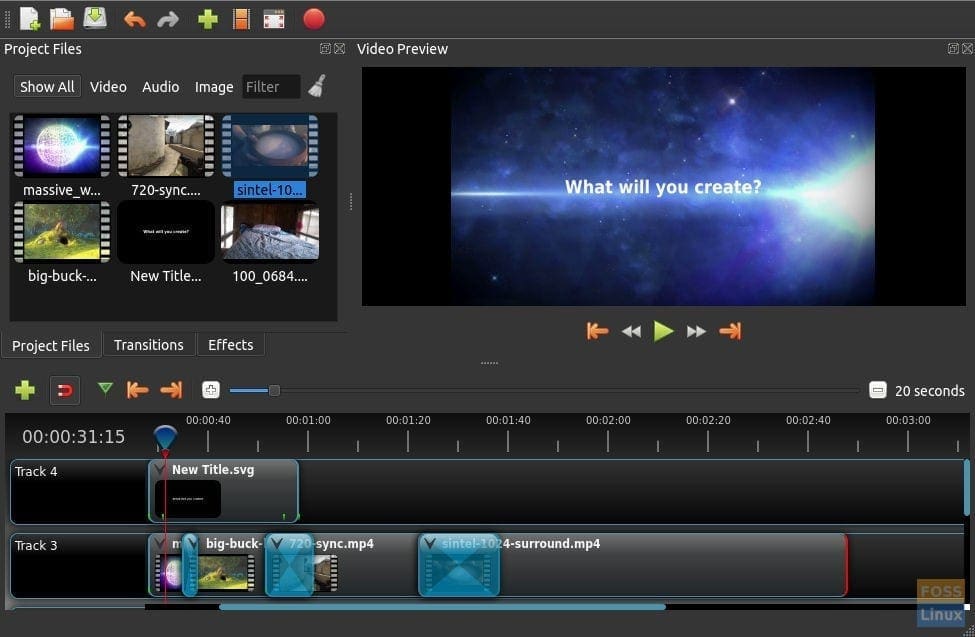
Openshot
OpenShot can prove to be another viable option for video editors planning on saving some money and opting for a FOSS product. Other than being available on platforms like Linux, macOS, and Windows, this software boasts a multitude of simple to sophisticated features that will help make the most out of your video editing skills. You’ll find support for unlimited tracks, keyframe-based animation, video transitions with real-time previews, and 3D animated effects/titles. Plus, importing media and working with clips becomes more comfortable thanks to its drag-and-drop support.
OpenShot can prove to be quite user-friendly for both beginners and experts. Another thing to note about OpenShot is that it doesn’t distinguish between audio and video tracks in its timeline, so all of them will be in a straight line.
4. Blender
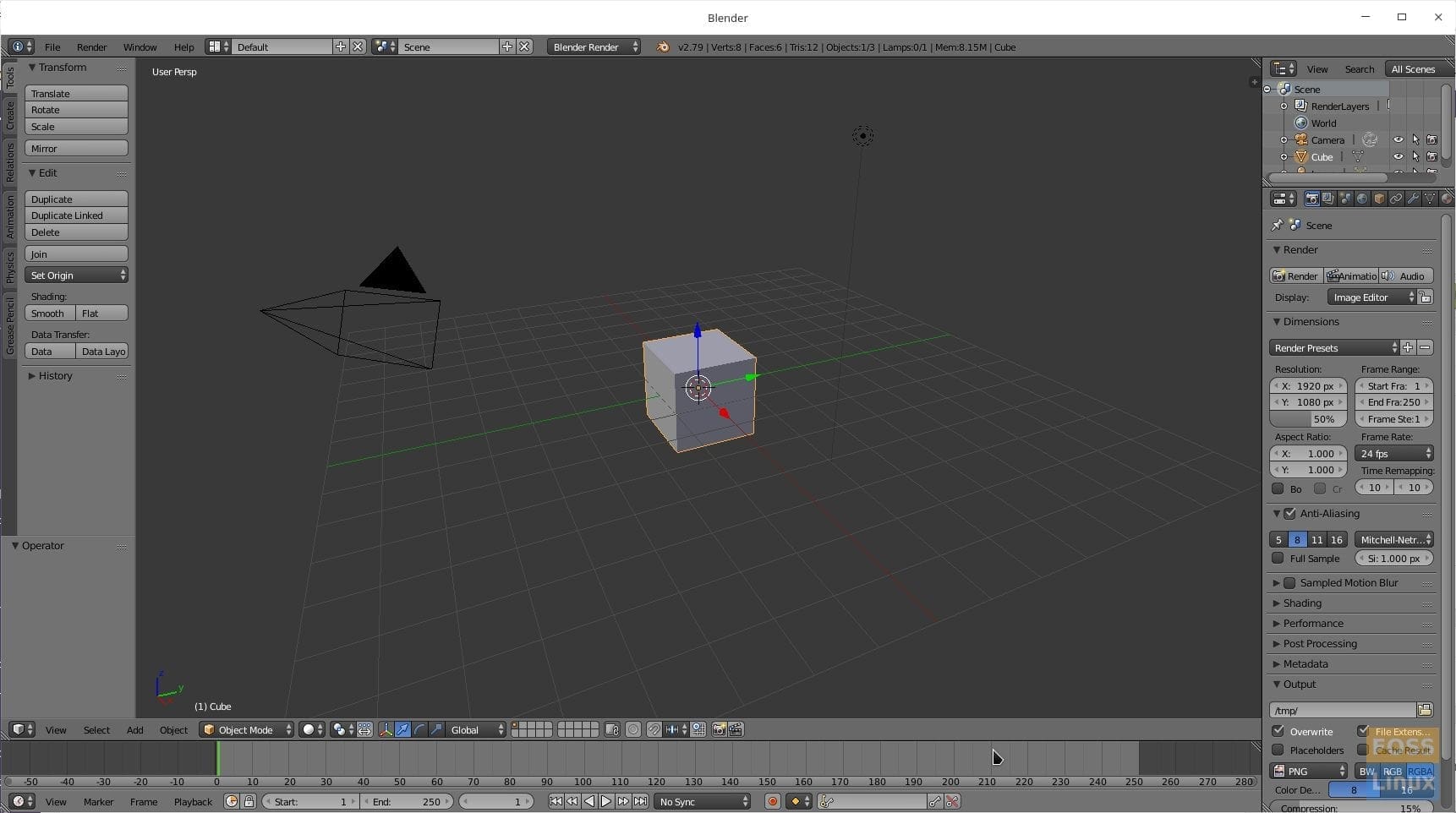
Blender on Deepin Linux
Although one might think of Blender as a 3D creation tool, the software has more in store for users. This application can also be used for video editing, and we’re not talking about basic features like trimming, joining and moving clips. Blender makes a powerful video editing software that accompanies several advanced features, such as the ability to create virtual effects and animation. The software has a multi-track timeline and makes video editing even faster with several keyboard shortcuts. You can also apply Blender add-ons to get more functionality out of the software.
Another great thing about Blender is that its user interface won’t bore or confuse the users. With that being said, since the application is mainly geared toward 3D creation, it would make sense if it’s not your cup of tea. However, if you’d like to give a shot to Blender, the software is fortunately available on Windows, macOS, and Linux.
5. VidCutter
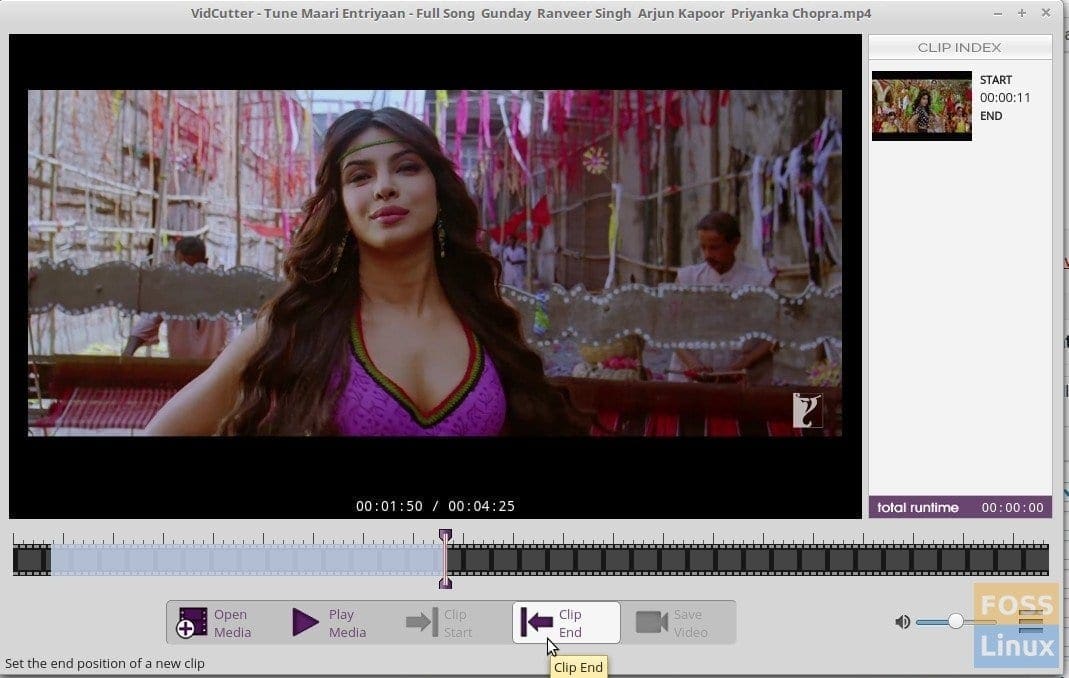
VidCutter App
If it’s a basic video editing tool you’re after, it makes no sense to spend even a penny out of your pocket. This free, open-source software called VidCutter might be what you need if adding, cutting, and splitting different clips would do the job for you. The application takes pride in offering a straightforward user interface that comes with no learning curve. Accordingly, even if you’re new to video editing, you won’t encounter one single hurdle using this software right from the start. Not only that, but VidCutter can work with popular file formats such as MPEG, MP4, MOV, and AVI. Plus, the software also offers a dark mode feature, which is impressive considering the minimalistic nature of VidCutter.
However, you are better off sticking to any of the first three entries on this list if high-level video editing is what you need. If that’s not the case, there’s no stopping you from opting for VidCutter, which supports all Windows, macOS, and Linux-based systems.
6. Natron

Natron
Although you’ll find many video editing elements missing from this software, Natron truly shines in its video production abilities. If you need some post-production features, you should opt for this VFX and motion graphics compositing program. By using Natron, you will be able to use motion tracking and chroma keying for replacing backgrounds. Other advanced features include curve and dope-sheet editor, GPU and network rendering, and flexible rotoscoping. Since Natron mainly focuses on post-production, your best bet would be to couple it with any other video editor on our list to produce a full video with audio and other scenes.
With so many complex features, it’s safe to say that absolute beginners would have a hard time getting the hang of Natron. However, we recommend looking at its user guide if you genuinely are interested in doing post-production using Natron. Besides supporting Windows, macOS, and Linux-based systems, this software can also run on the FreeBSD operating system.
7. Olive
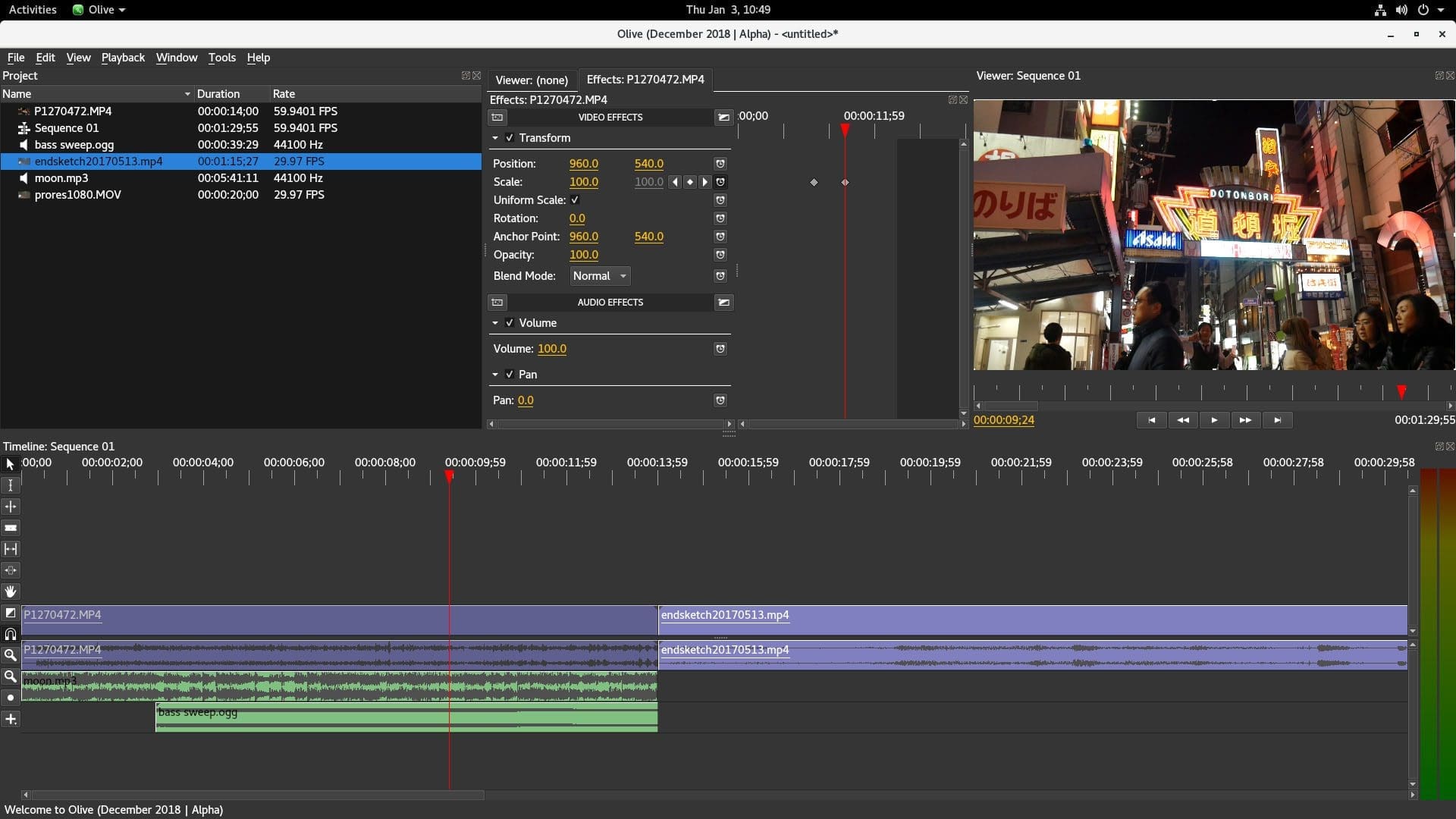
Olive Video Editor
We have an unpopular but underrated video editing application that can even give a tough time to the big dogs of this game. This non-linear video editor claims to have all the tools one would need to produce professional, high-grade videos. Although other entries on this list are more mature than Olive, its developers are working hard to introduce new features to this software each day. Another highlight of this application is its Bézier-curve animations, which you won’t find in the most famous open-source video editors. And though this software is meant for professionals, it has a minimal learning curve owing to its simple user interface.
However, before you go for Olive, it should be kept in mind that this software is still in the alpha phase, so you could encounter a few issues while installing or using this video editor. If that’s not a problem, you can download its latest build, which supports all popular operating systems, including Windows, macOS, and Linux.
8. Avidemux
Again, if you need basic editing tools, there’s no good in going for bulky video editing software with a sophisticated user interface. Instead, Avidemux is best suited for these jobs where you have to cut, trim, or filter your videos. The application also allows users to sharpen the image or reduce noise to enhance their clips. Although Avidemux doesn’t come with a timeline to arrange your clips, you’ll still be easily able to perform all the basic video editing tasks with it. Not only that, but the software also allows the automation of functions, job queues, projects, and robust scripting capabilities.
With Avidemux, you can work with various file formats such as ASF, MP4, MPEG, DVD, and AVI. Also, the developers release frequent updates to Avidemux, so you shouldn’t have a buggy experience. Lastly, whether you use macOS, Windows, or Linux, the software is available on all these operating systems.
9. LiVES

LiVES
Before discussing the video editor, we’d like to clarify that LiVES is currently not available on the Windows platform, even though its official website says that it will start supporting Windows by the end of 2019. So, we can’t tell when this software will truly become cross-platform, but it is a viable option for those using macOS or Linux.
LiVES is a non-linear video editor whose target demographic mainly consists of video jockeys. Nevertheless, it has plenty of video editing tools to help users combine video and audio clips in real-time and perform basic to intermediate-level editing tasks with ease. Another impressive thing about LiVes is that it features a multi-track timeline where you can place and arrange the clips. Users can also add colors, swirls, fades, and other such effects to their imported media. And, since it’s an application for video jockeys, you’ll also get access to some cool features like scratching and VJ keyboard control during playback.
10. VLMC

VLMC
VLMC is another product of the VideoLAN organization that is yet to go mainstream, unlike other entries on our list. However, this could be because this software is still under development and is only available in source code. Accordingly, some users might find it difficult to install VLMC on their system, though it is cross-platform and supports macOS, Windows, and Linux.
Short for VideoLAN Movie Creator, this non-linear editing software features an easy-to-use UI and plenty of basic video editing tools. Plus, it can handle a wide variety of file formats too. Nonetheless, it’s still not ideal for professionals because it lacks many advanced features. With that being said, individuals who are tired of spyware and paying for software should definitely look into VLMC.
Conclusion
Open-source software can be quite useful for video editors who are either short on cash or like having everything customized. Therefore, while compiling this list, we made sure to include as different video editors as possible so that our readers can find at least one product that suits their needs. However, if you feel like our list is missing out on an open-source video editing application you have in mind, please tell us your experience with it in the comment section below.

